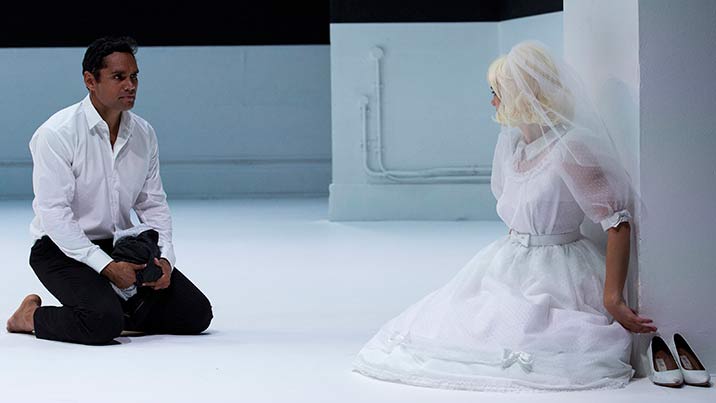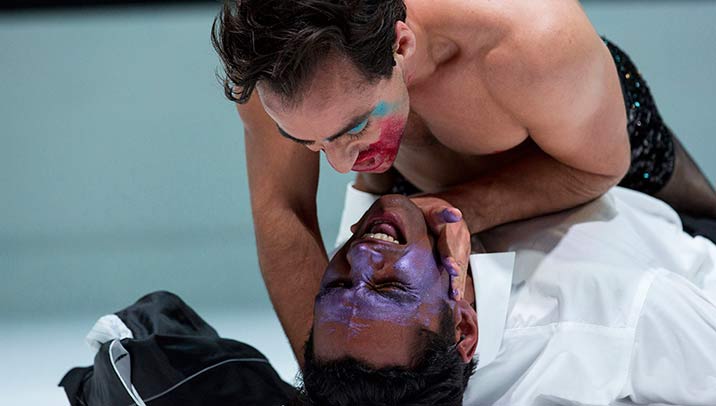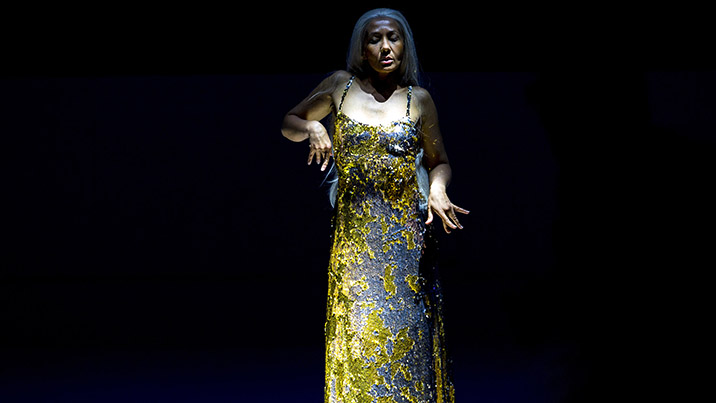Following darkness like a dream: STC’s A Midsummer Night’s Dream
Written by Claire Hansen in Performances and Productions | 01.10.2016
In Puck’s penultimate speech of A Midsummer Night’s Dream, he bridges the dancing frivolities of the Athenian and fairy courts with a dark vision of graveyards and hauntings:
Now the hungry lion roars,And the wolf behowls the moon,Whilst the heavy ploughman snores,All with weary task fordone.Now the wasted brands do glowWhilst the screech-owl, screeching loud,Puts the wretch that lies in woeIn remembrance of a shroud.Now it is the time of nightThat the graves, all gaping wide,Every one lets forth his spriteIn the churchway paths to glide;And we fairies that do runBy the triple Hecate's teamFrom the presence of the sun,Following darkness like a dream,Now are frolic. Not a mouseShall disturb this hallowed house.I am sent with broom beforeTo sweep the dust behind the door.(5.1.362-381)
Sydney Theatre Company’s (STC) current production, directed by Kip Williams, seeks to harness that dream-like darkness and ‘tilt the scales in favour of the tragic’ (Director’s Note: Kip Williams).

The restrained design (set design by Robert Cousins and costume design by Alice Babidge) relies effectively on a black-and-white aesthetic, with a strip of white across the bottom third of the stage, and the characters – with the exception of the fairy king and queen and the mechanicals – dressed in white and black. The Athenian women wear sombre, conservative wedding gowns – and even the stage itself is veiled for the opening scenes. This is augmented by pulsating, eerie music (composer Chris Williams and sound designer Nate Edmondson) and excellent lighting (by Damien Cooper) – particularly striking were the first opening frames of Puck, played with eerie, malevolent joy by Matthew Backer.
Williams’ Dream overwhelmingly embraces its exploration of darkness and eroticism. But the sexuality on display is never playful or joyful, but always tinged with violence. When the unsuspecting Lysander (Rob Collins) and Demetrius (Brandon McClelland) are smeared with the purple potion derived from the love-in-idleness flower, they moan as if in the throes of passion. The purple potion smeared across Titania’s face (an outstanding performance from Paula Arundell, who doubles as Hippolyta) comes to resemble heavy bruising around her eyes, visibly reinforcing the violent subjection and abuse suffered by women in this play.

STC’s production is not subtle about explicating the patriarchal repression inherent in not only the Athenian world of the play – where Egeus (Bruce Spence, who also plays Tom Snout and ‘Wall’) and Theseus (Robert Menzies, who also doubles as Oberon) control the marital choices of the women around them – but also in fairyland, where Titania is manipulated into a sexual relationship with an animal in order to control enable Oberon to secure his objective (that is, ownership of Titania’s ‘Indian boy’).
However, in its efforts to display the repressive patriarchy at work, the play deliberately limits the potential agency of its female characters, which could be read as a repressive act in itself. At the end of the play, after Titania’s enchantment has been lifted and Bottom’s donkey head removed, Titania and Bottom (with donkey head returned) meet again at the back of the stage, where Titania kneels, mouth pressed to the donkey’s face – which is attached to Bottom’s groin. The production thus locks Titania into this subjugated position, and minimises her role in the final fairy dance in Theseus’ home, which moves away from her role in the text and obliterates Titania’s power as an active agent in the dance.

Titania/Hippolya (it is difficult to conceptualise them as individuals) is a haunting and central figure, despite – or perhaps because of – this treatment. Her glittering diva-esque persona and her breaking out into song (‘Only you’) at the sight of Bottom lend her a tragic beauty. She is often the focal point of the staging, and in the highly controlled world of Athens, Hippolyta is always placed slightly off-centre, while everyone else is symmetrically organised. Titania’s reaction to discovering Oberon’s enchantment attests to the horror, gravity and depravity of Oberon’s manipulative violations, and is a stark, standout moment which highlights the play’s brutality.
In following darkness, the play generates a vision of the fairies that is distorted and grotesque. It is a far cry from a family-friendly wings and sparkles version. Costumed in body suits, with fluoro green wigs, and strange appendages, the fairies are less ethereal and more disturbing.
The ‘transformation’ or ‘translation’ of Bottom (a strong performance from Josh McConville) also tips towards the grotesque and tragic. When Puck emerges, arms soaked to the elbows in blood, we quickly realise the donkey’s head is not simply a harmless joke but is a decapitated head. Bottom’s body becomes stained in the donkey’s blood, and his coarse brays are not comical but painful. Rather than wearing the head, he carries it at groin-level for the majority of the scene, rather unsubtly reinforcing the already very clear implication of bestiality. Williams does not stop there, but leaves the audience at the end of the first half with a graphically clear depiction of the act to which Shakespeare alludes.

The production in general was a very bloody one, and was highly self-aware of the fact, mocking its own bloodiness in the performance of the play-within-a-play, Pyramus and Thisbe, when the mechanicals use a blood spatter machine to give extra panache to the death scenes of the eponymous characters.
However, the darkness of this production inevitably works against its comedy. The playfulness of the dialogue, the potential for hilarity in the exchanges between the lovers – not just the mechanicals – is muted by the choice to tip the scale in favour of darkness. As a spectator, you can feel the audience recognise the points where laughter should be, but the production fights against those moments. This is interesting and innovative, but at times feels a little forced and one-dimensional.
This darkness, of course, makes the role of the mechanicals even more vital, and the play survives on the laughter which they generate. Bottom is, as the part tends to be, a crowd favourite, but the disturbing donkey head and Bottom’s blood-stained body does not let you forget the darker side of the production. His body serves as the bridge between comedy and tragedy, and as such he is the epicentre of the production.
During the performance of Pyramus and Thisbe, which was performed to wide applause and is typically a favourite moment for the crowd, the onstage audience – the lovers, Theseus and Hippolyta – do not crack a smile. The banter of Demetrius and Lysander is cut, and the few lines left in – mainly Theseus’ – do not fit well in the production, and were often laughed over by the offstage audience. This was the epitome of the jarring clash between tragedy and comedy; the three pairs of couples are determined not to be in a comedy, and they fight it as hard as they can.
The lovers’ physical antics and rough-housing as their confusion grows is the perfect vehicle for Williams to explore the development of sexuality in which the production is clearly interested. Some moments are delightful, such as Helena’s (Honey Debelle) initial positive response to Demetrius’ affections, as she loses herself in the kiss, before she begins to suspect trickery. The white bridal gowns and the black and white suits are gradually discarded, and although the four lovers’ slapstick comedy was amusing, it does not lead anywhere. The lovers arrive at no realisation nor develop their sexual maturity. Instead, they seem trapped in a dreamy state which stalls any forward movement. It does not appear that self-awareness or enlightenment has been achieved.
This was heightened by the decision to repeat the lovers’ lines at the play’s end; it locked the lovers into what seemed an inability to break out of the dream, or to fully realise they were not dreaming. This sense of stasis is echoed in Bottom and Titania’s reprisal of their enchanted personas at the conclusion of the play.
In some ways, I think the production is fighting against a stereotypical idea of Midsummer's that has already dissipated. As Andrew Upton writes in his program message, ‘a saccharine varnish of lycra fairies and insipid comedy has been applied to the text’. This is echoed by Williams’ reference to ‘the cultural cotton wool that surrounds this text’. This production is a strident reaction against this, but it is not necessarily a nuanced reaction.
Williams’ production can be usefully contrasted to the recent Globe production of A Midsummer Night’s Dream, the first of that theatre’s new artistic director, Emma Rice (you can currently watch this production here). This performance, which took a Bollywood-inspired theme, delved wholeheartedly into the play’s humour and ludic potential: joyful, colourful, uproarious, interactive. In this way, it is the antithesis of the current STC production. The Globe’s playful, sillier version, though, does not mean the production cannot raise challenging and subversive discussions about gender and sexuality. Rice chose to turn Helena into Helenus as a response to the treatment of women in the play and as a means to explore a broader understanding of sexuality. Rice’s production takes Puck’s line, ‘Jack shall have Jill; /Nought shall go ill’, and turns it into a shared song between Oberon and Titania, who add , ‘Jack shall have Jack, Jill shall have Jill’, and so on. A woman also played both Puck and the patriarchal figure of Egeus. The comparison shows that you don’t necessarily need total darkness to illuminate troubling issues of sexual violence, repression and abuse.
Sydney Theatre Company’s production of A Midsummer Night’s Dream presents a strong, clear vision for its production: less a dream than a hopeless nightmare, the worlds onstage are dangerous and difficult for women to navigate; sex is entangled with abuse, violence, and exploitation of power; and love seems virtually absent. It is intriguing, confronting and inventive in its exploration of darkness, but also a little imbalanced.
A Midsummer Night's Dream is playing at the Opera House until 22 October 2016.
